Difference between revisions of "Cow leather"
(Created page with "<p align=center> 300px </p> <p align=center> 167px 167px bild:Bulle-01.jpg|...") |
|||
| (12 intermediate revisions by one user not shown) | |||
| Line 11: | Line 11: | ||
| − | == | + | ==What is cow leather?== |
| − | + | Globally, there are approximately 1.6 billion cattle, including [[Calfskin|calves]], [[Water buffalo leather - Buffalo leather|buffaloes]] and [[Zebu leather|zebus]] (as of 2011). 15 to 25% of these are slaughtered annually. Cow leather is the most widely used leather and accounts for about 65 to 70% of [[Leather industry|world production]]. Almost 100% of the slaughtered cattle and calves are used. Approx. 93% is processed into meat products, approx. 3.5% are fats, bones etc. which are also processed and 3.5% are skins which are processed into [[leather]]. Even the hair that is removed during [[leather production]] is not dissolved during the [[Liming - Leather Tanning|liming process]] in modern [[tannery|tanneries]], but processed into fertilizer. | |
| − | + | The [[rawhide|cattle hides]] usable for the [[leather industry]] were given as 270 million in 2021. Cow leather is used for [[shoe leather|soles and uppers of shoes]], for [[car leather|car seats]] and [[leather furniture|furniture upholstery]], [[leather belt|belts]] and [[leather straps|straps]], [[leather saddle|saddles]], [[leather clothing]] and much more. There is hardly any area in which bovine leathers or [[Calfskin|calf skins]] are not processed. | |
| − | In | + | In Brazil, there are 206 million cattle, which is the world's largest stock of cattle. That is 14.2% of the world total (as of 2013). |
| + | <br> | ||
<p align=center> | <p align=center> | ||
| − | + | <flashow>//www.youtube.com/v/CF-FnqrqgCQ&fs=1&color1=0x660000&color2=0x550000&border=1|width=500|height=281,25</flashow> | |
| − | + | </p> | |
| − | + | <p align=center> | |
| − | + | ''How to make the best use of our limited agricultural land.'' | |
</p> | </p> | ||
| − | + | In Italy, which is by far the largest [[tanning leather|leather manufacturer]] in Europe, almost 100 million square metres of cow leather were produced in 2011. In Germany, the third largest beef leather producer in Europe after Spain, only 8.5 million square metres were produced. | |
<p align=center> | <p align=center> | ||
| − | [[bild: | + | [[bild:Moebel-Anilin-002.jpg|250px]] |
| − | [[bild: | + | [[bild:Guertel-Praegungen-001.jpg|250px]] |
| − | [[bild: | + | </p> |
| + | <p align=center> | ||
| + | [[bild:Oldtimer-001.jpg|250px]] | ||
| + | [[bild:Schuhauslage-hochwertig-001.jpg|250px]] | ||
</p> | </p> | ||
| − | + | Since beef is consumed world-wide, sufficient [[Rawhide|raw skins]] are also available for [[leather production]] and the price is therefore affordable. Cattle for meat production are slaughtered after around 24 months. Dairy cows and bulls live longer, but their skins then also have more [[Natural markings on leather|skin damage]] from parasites, injuries and signs of aging of the skin. | |
<p align=center> | <p align=center> | ||
| − | [[bild: | + | [[bild:Rindfleisch-Steak-04.jpg|250px]] |
| − | [[bild: | + | [[bild:Rindfleisch-Hamburger-01.jpg|250px]] |
| − | [[bild: | + | </p> |
| − | + | <p align=center> | |
| + | [[bild:Rindfleisch-Steak-02.jpg|500px]] | ||
</p> | </p> | ||
| − | + | Bovine leather is [[leather quality|stable and firm]] and therefore versatile. The hides are [[Measures and weights|large enough]] to be used for extensive areas. The surface of a cattle leather skin is about five square metres. For a large [[leather furniture|sofa]], roughly 25 square metres of leather is needed. Depending on the size of the individual surfaces, the [[leather cutting waste|waste]] is between 30% and 45% and can be even higher for particularly large individual surfaces. However, there are differences between cattle breeds. A Bavarian cow usually yields twice as much skin area as a [[Zebu leather|zebu]]. Although, there are zebu skins sold by a company called Mastrotto from Brazil with 5.5 square metres. | |
| − | |||
| − | + | <p align=center> | |
| + | [[bild:Jacke-Rindsleder-003.jpg|250px]] | ||
| + | [[bild:Lederball-Cricket-001.jpg|250px]] | ||
| + | </p> | ||
| + | <p align=center> | ||
| + | [[bild:Fahrradsattel-Brooks-001.jpg|250px]] | ||
| + | [[bild:Lederkoffer-07.jpg|250px]] | ||
| + | </p> | ||
| − | |||
| − | + | Cow leather refers to various types of leather from cattle, such as bull hide or cow hide. Minor differences between species relate mainly to [[Natural leather grain|grain pattern]] and [[Haptic evaluation of leather surfaces|haptics]]. | |
| + | The typical density of a bovine leather skin is between 0.4 and 0.9 g/cm 3. | ||
| − | + | The tensile strength of cow leather is between 8 - 25 N/mm². | |
| − | + | Normally, only the surface skin of cattle is processed to [[leather]]. There are rare exceptions, such as the [[bull testicles]] or [[rumen leather]]. | |
| − | + | Depending on the age ([[calfskin]]), sex (the car industry processes mostly bull leather) and [[Leather weight - Lightweight Leather|weight]] (affects the size of the skin), [[Rawhide dealers - Skin collectors|rawhide dealers]] store the skins from the slaughterhouse and sell them to the [[tannery|tanneries]]. | |
| − | |||
| − | |||
| − | |||
| − | |||
| − | |||
| − | |||
| − | |||
| − | |||
| − | |||
| − | |||
| − | |||
| − | |||
| − | |||
| − | |||
| − | |||
| − | |||
| − | |||
| − | |||
| − | |||
| − | |||
| − | |||
| + | == [[Leather videos|Video]] about leather of different [[exotic leather|animal species]]== | ||
| + | <br> | ||
<p align=center> | <p align=center> | ||
| − | <flashow> | + | <flashow>//www.youtube.com/v/-tJtZmJCWLw&fs=1&color1=0x660000&color2=0x550000&border=1|width=500|height=281,25</flashow> |
</p> | </p> | ||
<p align=center> | <p align=center> | ||
| − | ''[[ | + | ''Leather of different animal species. - [[Exotic leather]].'' |
</p> | </p> | ||
== Additional information == | == Additional information == | ||
| − | * [[ | + | * [[Calfskin]] |
| − | * [[Zebu]] | + | * [[Zebu leather]] |
| − | * [[ | + | * [[Cowhide]] |
| − | * [[ | + | * [[Rumen leather]] |
| − | * [[ | + | * [[Bull testicles]] |
| − | * [[ | + | * [[Exotic leather]] |
| − | < | + | <logoplustext /> |
| − | + | ||
| − | + | ||
| − | + | ||
| − | + | ||
| − | + | ||
[[Kategorie:All Articles]] | [[Kategorie:All Articles]] | ||
[[Kategorie:Leather types]] | [[Kategorie:Leather types]] | ||
Latest revision as of 10:51, 7 February 2023
What is cow leather?
Globally, there are approximately 1.6 billion cattle, including calves, buffaloes and zebus (as of 2011). 15 to 25% of these are slaughtered annually. Cow leather is the most widely used leather and accounts for about 65 to 70% of world production. Almost 100% of the slaughtered cattle and calves are used. Approx. 93% is processed into meat products, approx. 3.5% are fats, bones etc. which are also processed and 3.5% are skins which are processed into leather. Even the hair that is removed during leather production is not dissolved during the liming process in modern tanneries, but processed into fertilizer.
The cattle hides usable for the leather industry were given as 270 million in 2021. Cow leather is used for soles and uppers of shoes, for car seats and furniture upholstery, belts and straps, saddles, leather clothing and much more. There is hardly any area in which bovine leathers or calf skins are not processed.
In Brazil, there are 206 million cattle, which is the world's largest stock of cattle. That is 14.2% of the world total (as of 2013).
How to make the best use of our limited agricultural land.
In Italy, which is by far the largest leather manufacturer in Europe, almost 100 million square metres of cow leather were produced in 2011. In Germany, the third largest beef leather producer in Europe after Spain, only 8.5 million square metres were produced.
Since beef is consumed world-wide, sufficient raw skins are also available for leather production and the price is therefore affordable. Cattle for meat production are slaughtered after around 24 months. Dairy cows and bulls live longer, but their skins then also have more skin damage from parasites, injuries and signs of aging of the skin.
Bovine leather is stable and firm and therefore versatile. The hides are large enough to be used for extensive areas. The surface of a cattle leather skin is about five square metres. For a large sofa, roughly 25 square metres of leather is needed. Depending on the size of the individual surfaces, the waste is between 30% and 45% and can be even higher for particularly large individual surfaces. However, there are differences between cattle breeds. A Bavarian cow usually yields twice as much skin area as a zebu. Although, there are zebu skins sold by a company called Mastrotto from Brazil with 5.5 square metres.
Cow leather refers to various types of leather from cattle, such as bull hide or cow hide. Minor differences between species relate mainly to grain pattern and haptics.
The typical density of a bovine leather skin is between 0.4 and 0.9 g/cm 3.
The tensile strength of cow leather is between 8 - 25 N/mm².
Normally, only the surface skin of cattle is processed to leather. There are rare exceptions, such as the bull testicles or rumen leather.
Depending on the age (calfskin), sex (the car industry processes mostly bull leather) and weight (affects the size of the skin), rawhide dealers store the skins from the slaughterhouse and sell them to the tanneries.
Video about leather of different animal species
Leather of different animal species. - Exotic leather.
Additional information







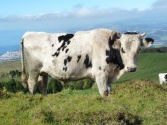
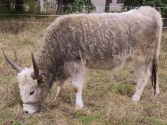
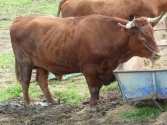
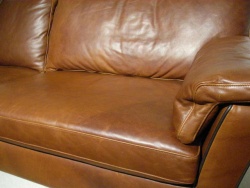
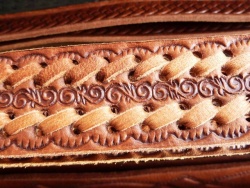

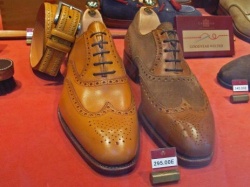
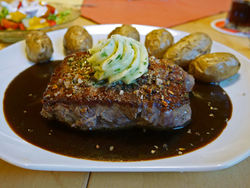
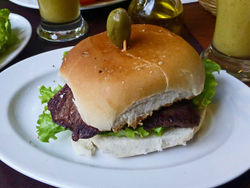
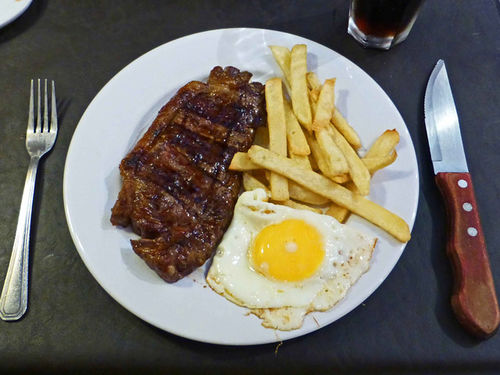
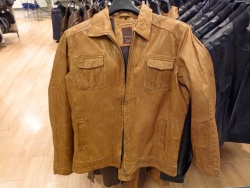
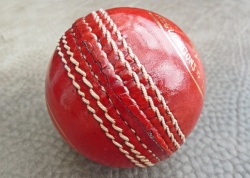
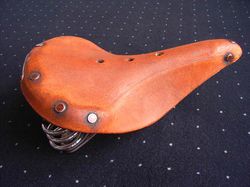
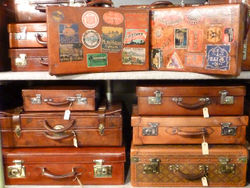

 a kotori web solution
a kotori web solution